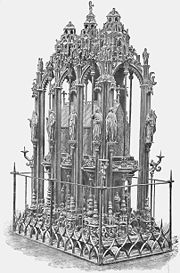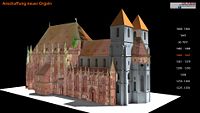
St. Sebaldus Church
Encyclopedia

Nuremberg
Nuremberg[p] is a city in the German state of Bavaria, in the administrative region of Middle Franconia. Situated on the Pegnitz river and the Rhine–Main–Danube Canal, it is located about north of Munich and is Franconia's largest city. The population is 505,664...
, Germany
Germany
Germany , officially the Federal Republic of Germany , is a federal parliamentary republic in Europe. The country consists of 16 states while the capital and largest city is Berlin. Germany covers an area of 357,021 km2 and has a largely temperate seasonal climate...
. Along with Frauenkirche (Our Lady's Church) and St. Lorenz, it is one of the most important churches of the city, and also one of the oldest. It is located at the Albrecht-Dürer-Platz, in front of the old city hall. It takes its name from Sebaldus
Sebaldus
St. Sebaldus of Nuremberg is venerated as the patron saint of Nuremberg, traditional administrative centre of Franconia, and the guarantor of its independence...
, an 8th century hermit
Hermit
A hermit is a person who lives, to some degree, in seclusion from society.In Christianity, the term was originally applied to a Christian who lives the eremitic life out of a religious conviction, namely the Desert Theology of the Old Testament .In the...
and missionary
Missionary
A missionary is a member of a religious group sent into an area to do evangelism or ministries of service, such as education, literacy, social justice, health care and economic development. The word "mission" originates from 1598 when the Jesuits sent members abroad, derived from the Latin...
and patron saint
Patron saint
A patron saint is a saint who is regarded as the intercessor and advocate in heaven of a nation, place, craft, activity, class, clan, family, or person...
of Nuremberg. It has been a Lutheran parish church since the Reformation
Reformation
- Movements :* Protestant Reformation, an attempt by Martin Luther to reform the Roman Catholic Church that resulted in a schism, and grew into a wider movement...
.

History




Romanesque architecture
Romanesque architecture is an architectural style of Medieval Europe characterised by semi-circular arches. There is no consensus for the beginning date of the Romanesque architecture, with proposals ranging from the 6th to the 10th century. It developed in the 12th century into the Gothic style,...
basilica
Basilica
The Latin word basilica , was originally used to describe a Roman public building, usually located in the forum of a Roman town. Public basilicas began to appear in Hellenistic cities in the 2nd century BC.The term was also applied to buildings used for religious purposes...
with two choirs. During the 14th century several important changes to the construction were made: first the side aisle
Aisle
An aisle is, in general, a space for walking with rows of seats on both sides or with rows of seats on one side and a wall on the other...
s were widened and the steeple
Steeple (architecture)
A steeple, in architecture, is a tall tower on a building, often topped by a spire. Steeples are very common on Christian churches and cathedrals and the use of the term generally connotes a religious structure...
s made higher (1309–1345), then the late gothic hall chancel
Chancel
In church architecture, the chancel is the space around the altar in the sanctuary at the liturgical east end of a traditional Christian church building...
was built (1358–1379). The two towers were added in the 15th century. In the middle 17th century galleries were added and the interior was remodelled in the Baroque
Baroque
The Baroque is a period and the style that used exaggerated motion and clear, easily interpreted detail to produce drama, tension, exuberance, and grandeur in sculpture, painting, literature, dance, and music...
fashion. The church suffered serious damage during World War II
World War II
World War II, or the Second World War , was a global conflict lasting from 1939 to 1945, involving most of the world's nations—including all of the great powers—eventually forming two opposing military alliances: the Allies and the Axis...
and was subsequently reconstructed. Some of the old interior did survive, including the Shrine of St. Sebaldus, works by Veit Stoss
Veit Stoss
Veit Stoss was a leading Bavarian sculptor, mostly in wood, whose career covered the transition between the late Gothic and the Northern Renaissance. His style emphasized pathos and emotion, helped by his virtuoso carving of billowing drapery; it has been called "late Gothic Baroque"...
and the stained glass
Stained glass
The term stained glass can refer to coloured glass as a material or to works produced from it. Throughout its thousand-year history, the term has been applied almost exclusively to the windows of churches and other significant buildings...
windows.
Organ
The church had an organ by the 14th century, and another by the 15th. The main organ had been built in 1440–41 by Heinrich TraxdorfHeinrich Traxdorf
Heinrich Traxdorf was an early German organ builder. He was born in Mainz, probably in the beginning of the 15th century. During the 1440s he built three organs in Nuremberg and one in Salzburg, for St...
, who also built two small organs for Nuremberg's Frauenkirche. Until its destruction in the 20th century it was one of the oldest playable organs in the world, and all the more notable because Traxdorf was one of the first organ builders to depart from the gothic Blockwerk organ by dividing the windchests and separating the front stops
Organ stop
An organ stop is a component of a pipe organ that admits pressurized air to a set of organ pipes. Its name comes from the fact that stops can be used selectively by the organist; some can be "on" , while others can be "off" .The term can also refer...
into Flute (Principal) and Octave (see pipe organ
Pipe organ
The pipe organ is a musical instrument that produces sound by driving pressurized air through pipes selected via a keyboard. Because each organ pipe produces a single pitch, the pipes are provided in sets called ranks, each of which has a common timbre and volume throughout the keyboard compass...
). The Traxdorf organ was rebuilt in 1691. The modified case was destroyed by the Allied forces
Allies of World War II
The Allies of World War II were the countries that opposed the Axis powers during the Second World War . Former Axis states contributing to the Allied victory are not considered Allied states...
during a bombing raid on 2 January 1945. The new 4 manual, 122 rank, 84 stop organ by Peter, Köln, was installed in 1975.
The position of organist of St. Sebaldus was the most important one of this kind in Nuremberg, and several important composers occupied this post. Organists who worked at St. Sebaldus include the following (almost all held the post until their death, except where stated otherwise):
- 1446-1450: Conrad PaumannConrad PaumannConrad Paumann was a German organist, lutenist and composer of the early Renaissance. Even though he was born blind, he was one of the most talented musicians of the 15th century, and his performances created a sensation wherever he went...
, secretly left for MunichMunichMunich The city's motto is "" . Before 2006, it was "Weltstadt mit Herz" . Its native name, , is derived from the Old High German Munichen, meaning "by the monks' place". The city's name derives from the monks of the Benedictine order who founded the city; hence the monk depicted on the city's coat... - 1567-1571: Hans Haiden
- 1596-1616: Hans Christoph Haiden, dismissed for adulteryAdulteryAdultery is sexual infidelity to one's spouse, and is a form of extramarital sex. It originally referred only to sex between a woman who was married and a person other than her spouse. Even in cases of separation from one's spouse, an extramarital affair is still considered adultery.Adultery is...
- 1616-1618: Kaspar Hassler
- 1618-1634: Johann StadenJohann StadenJohann Staden was a German Baroque organist and composer. He is best known for establishing the so-called Nuremberg school.-Life:He was the son of Hans Staden and Elisabeth Löbelle...
- 1634-1658: Valentin Dretzel
- 1658-1686: Paul Hainlein
- 1686-1695: Georg Caspar WeckerGeorg Caspar WeckerGeorg Caspar Wecker was a German Baroque organist and composer. A minor composer of the Nuremberg school, Wecker is now best remembered as one of Johann Pachelbel's first teachers....
- 1695-1706: Johann PachelbelJohann PachelbelJohann Pachelbel was a German Baroque composer, organist and teacher, who brought the south German organ tradition to its peak. He composed a large body of sacred and secular music, and his contributions to the development of the chorale prelude and fugue have earned him a place among the most...
- 1706-1719: J.S. Richter
- 1719-1764: Wilhelm Hieronymus PachelbelWilhelm Hieronymus PachelbelWilhelm Hieronymus Pachelbel was a German composer and organist, elder son of Johann Pachelbel.Born in Erfurt near Eisenach , Pachelbel studied with his father. The first printed reference to either Pachelbel is in Johann Mattheson's Ehrenpforte...
(Johann's son) - 1764-1775: Cornelius Heinrich DretzelCornelius Heinrich DretzelCornelius Heinrich Dretzel was a German organist and composer. He was born in Nuremberg, where he appears to have spent his whole life in various organists' posts. He may have studied with J.S. Bach in Weimar , and his compositions reveal points of contact with Bach...
- 1969-1991: Werner Jacob (left)
External links
St. Sebald Official Site- St. Sebald at the official site of Nuremberg Includes a brief description in English
- St. Sebaldus church at Archiseek.com Includes brief descriptions and photographs
- Saint Sebald Church digital media archive (creative commonsCreative CommonsCreative Commons is a non-profit organization headquartered in Mountain View, California, United States devoted to expanding the range of creative works available for others to build upon legally and to share. The organization has released several copyright-licenses known as Creative Commons...
-licensed photos, laser scans, panoramas), data from a Christofori und Partner/CyArkCyArkCyArk is a 501 nonprofit organization located in Oakland, California, United States. The company's website refers to it as a "digital archive of the world’s heritage sites for preservation and education"...
/Bavarian State Department of Monuments and Sites research partnership

